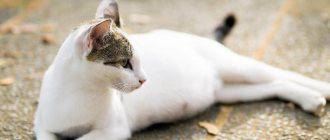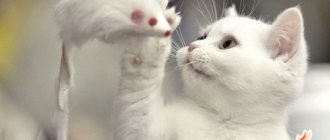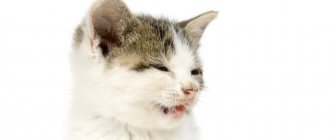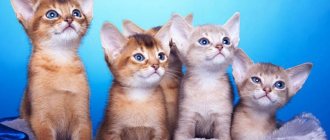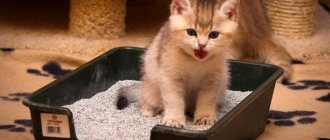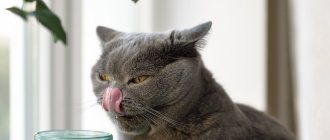Breed table
| Breed name | Chantilly Tiffany (Chantilly race de chat, foreign longhair) |
| Path of occurrence | Targeted breeding |
| Country of origin | USA, Canada, according to some sources UK |
| Coat | Longhair or semi-longhair |
| Lifespan | 16 – 20 years |
| Kitten price | from 45 thousand rubles |
Education and training
Turkish Van (cat breed): description and features
This breed is distinguished by good manners and intelligence. Cats easily learn to use the litter box and calmly walk outside in a harness with their owner. Pets quickly adapt to the existing regime and easily get comfortable when moving to a new place or cottage. A well-trained cat actively responds to its name, knows its place and does not bother its owners, keeping itself busy on its own. Tiffany is good with children and can be a wonderful playmate for a baby. However, if the child begins to pester the pet too intrusively, he may release his claws.
Animals are easy to train, but first you need to find an approach to them
Note! In addition to her spectacular appearance, Tiffany has a high level of intelligence. This is a cunning and capricious animal that can be either charmingly cute or demandingly capricious.
Proper nutrition for cats
The most important requirement for a cat's nutrition can be called balance combined with thoughtfulness. This means that it is important to carefully understand what you can feed your pet and what not. For those who are planning to feed their cat dry food, it is important to remember that there is nothing wrong with it. It is important to choose the right manufacturer to provide the animal with quality nutrition.
But sometimes a cat can develop all sorts of diseases from such a monotonous diet. In order to avoid this, it is important to diversify it with natural products. Cereal porridges, boneless fish, eggs, and dairy products are excellent for this purpose.
It is important to remember that you should not overdo the last point, as this can create serious problems with the gastrointestinal tract. There is no need to neglect proper nutrition for kittens, since the health of your pets depends on its quality.
Description of the breed
Chantilly-Tiffany standard:
- Body: muscular, large, heavier than you might think. The chest is wide, large, rounded. Cats weigh on average 3 kg, and males - about 5 kg.
- Limbs: Short but proportionate legs. Graceful rounded small paws. The tail is not very long, fluffy, plume-like and tapering at the end.
- Head: shaped like a blunt wedge, rather short. The clear profile is intricately curved and clearly defined. The chin is not massive, but strong, the lower jaw is wide. The cheekbones are pronounced and smoothly defined.
- Eyes: wide-set, expressive. Color – amber, yellow, maybe a mixture of green or smoky.
- Ears: widened at the base, set at the edges of the head and protruding slightly forward. The tips are sharp, there may be small brushes or tassels on the tips of the ears, but this is not necessary. The lines of the ears exactly follow the contour of the head.
- Coat: semi-long or long, soft. It lacks undercoat, but is not rare. Lying tightly to the body on the back, the coat forms sloppy “pants” on the hind legs and a chic collar.
- Color: Chocolate color is the most prized. Also found: black solidus, blue, lilac, cinnamon and fawn. It may have a pattern in the form of spotted tabby, tabby, or mackerel. There are also unrecognized ones: cameo, silver smoke, tabby, ticked tabby, red cake, tabby.
Reference! A characteristic feature of these cats is the unevenness of color: it seems to be lightened in some areas of the body and darkened in others.
Origin story
The history of cats with such an intriguing name was for a long time covered in a veil of secrets, which scientists were able to unravel only in the early nineties of the last century. Until this time, the Tiffany was considered a subspecies of the Burmese cat, and was not recognized by most experts as an independent breed.
The story of these charming creatures began in 1967 in North America. An American named Jenny Robinson accidentally saw two fluffy chocolate-colored kittens in a pet store, which she bought as pets. The babies turned out to be of different sexes, and two years later they already had several kittens, which were smaller copies of their parents. Jenny decided that chocolate babies with amber-yellow eyes would be in demand among cat lovers, so she even bred these animals for some time.
But after some time, the woman lost interest in her pets, and the baton of breeding fluffy beauties was picked up by a professional breeder of Burmese cats, Sijin Lund. She decided to buy the remaining cats from Jenny and cross them with Burmese to create a new breed. Soon, Sijin presented the results of her work to local felinologists, calling the new breed “Foreign Longhaired Cat.”
This name seemed too long to specialists, which became the reason for their refusal to officially register the new breed. Then Sijin came up with another name for her favorites - Tiffany, but even this did not help her achieve recognition for chocolate beauties. The disappointed breeder decided to stop all attempts to breed a new breed, so by the end of the eighties the number of these cats had decreased significantly.
Chantilly Tiffanys might have remained unknown to anyone if the Canadian breeder Tracy Oraas had not become interested in them, who set out to prove that the Burmese had nothing to do with the appearance of chocolate cats. Tracy involved her friend and breeder Jan DeRegt in her investigation, and they still managed to convince the experts that in the history of the pedigree of these cats there was no Burmese breed, and their ancestors were Siamese cats.
Moreover, the woman decided to develop a completely new breed, so she crossed Tifanny first with Abyssinian cats, and then with European Angora cats. The new breed was registered under the name Chantilly-Tiffany, although these cats have not yet received official recognition by international organizations.
Personality of Chantilly Tiffany cats
Cats can boast of a wonderful character: moderately active, not intrusive, but owner-oriented. They usually choose one or two people and give them all their love and affection, but they can also live in a large family with children and other animals.
There is no need to be afraid: they will not conflict, and the company of other cats, and even dogs, will not allow them to mope alone. Chantilly will not touch a child, even the most active one; in extreme cases, he will simply leave.
Cats of this breed are curious, especially in childhood, so you should secure the room: do not open windows, put indoor flowers and wires away.
Character traits
In the photo, Chantilly Tiffanys look like calm and dignified animals. But this is exactly the case when appearances can be deceiving. These luxurious furry creatures are extremely playful and inquisitive, and take an active part in the daily life of their owners . Not a single event in the house will pass by Tiffany's observant gaze, from cleaning to arranging food in the refrigerator.
At the same time, the character of these cats is very gentle and affectionate, and they need constant attention and communication. Of all the members of the Chantilly-Tiffany family, they choose one person as their owner, and remain devoted to him for the rest of their life.
These cats get along well with children, and when playing with them they behave extremely carefully. Therefore, there is no need to fear that these animals will harm the child. Tiffany will also treat other pets calmly, but prefer to keep a distance from them. These cats do not like the presence of strangers in the house, and treat guests with some caution and wariness.
Another distinctive character trait of the Chantilly-Tiffany cat breed is its unobtrusiveness and patience. Although they love to interact with their owner and enjoy sitting in his arms, these furry creatures will never demand attention if the owner is busy. These cats sometimes like to hide in secluded places, so it is recommended to purchase a special cat house for them, where the pet can retire and take a break from everyone.
Care
Caring for such cats is easy. Regular combing is necessary - at least once every 2 days . The fur usually does not tangle or turn into tangles, but during molting it can cause a lot of problems for the owner in the form of mandatory daily cleaning.
You should feed your cat natural food, trying to achieve a balanced diet, or food of at least premium class: they are selective when it comes to food. It is important to ensure timely removal of fur from the stomach; special malt pastes will help cope with this.
Cleaning the ears and teeth is also necessary. Particular attention should be paid to the eyes: discharge from them is one of the characteristics of the breed. The eyes should be wiped with a cotton pad soaked in boiled water. But the absence of discharge should, on the contrary, alert you.
Useful video about the breed:
Feeding
Feeding these animals will also not pose any particular hassle, because Tiffanys are quite unpretentious in their choice of food. They can be fed both ready-made dry food and natural food, giving preference to lean meats.
Once a week, it is advisable to give the animals a special paste intended for long-haired cats, which helps dissolve the hair in the stomach.
Kitten price and nurseries
The breed is considered extinct and there are no large nurseries preserving the phenotype. Although its possibly not purebred representatives are still found among amateurs.
Reference! There are no Chantilly Tiffany catteries in Russia; the cats are very rare. It is possible that there are several breeders abroad who are breeding.
You can look for a kitten abroad: USA, Canada, Scandinavia, and be prepared to pay about $700 for it. Non-professionals can easily become victims of scammers and confuse him with an ordinary yard cat.
Share your impressions about the breed in the comments to the article. Would you like such a long-haired beauty or do you already have favorites among other breeds?
Health and illness
The Chantilly Tiffany is a cat with good health. She did not inherit any diseases from her ancestors, so her body is extremely rarely affected by congenital and acquired pathologies. In addition, Chantilly has strong immunity, so they do not suffer from viral diseases. The most common problems are with weight and with the nervous system.
Obesity
Symptoms of obesity in a cat:
- The cat's weight is 20% or more higher than normal.
- Severe shortness of breath with little activity.
- Mobility problems.
- Inability to feel the ribs or spine through the fat layer.
What causes obesity:
- Genetic predisposition.
- Uncontrolled eating.
- Hormonal disbalance.
- Lack of sufficient physical activity.
Obesity is much easier to prevent than to cure. To do this, the cat needs to ensure maximum physical activity and proper, balanced feeding, as well as suppress any attempts to steal food or begging. But if the cat has gained excess weight, then treatment involves diet, physical activity and, if necessary, taking hormonal medications.
Obesity causes many problems for cats: diabetes, joint diseases, disorders of the cardiovascular system and much more.
Obsessive-compulsive disorder
Obsessive-compulsive neuroses are nothing more than a protective reaction of the cat’s nervous system to stress. It is designed to distract her from an unpleasant situation. The main symptom is that the cat grooms itself for too long and thoroughly, sometimes until bald spots form. In constant stressful situations, this becomes a habit, and eventually such a reaction occurs even to the most insignificant stimuli.
Other symptoms of neurosis:
- Fixed gaze, hunting for imaginary prey, clicking teeth, beating the air with paws.
- Excessive consumption of food and (or) water, excessive salivation, “sucking” of wool and other materials.
- Tail wagging, head shaking, jumping into the air for no reason, increased motor activity, increased sensitivity to cold.
- Frequent meowing.
- Biting paws or tail, causeless aggression towards people.
In some cats, obsessive-compulsive disorder arises from boredom or lack of communication with the owner.
Treatment of neurosis is long and labor-intensive and is based on minimizing stressful situations and a certain technique for correcting behavior and getting rid of neurotic habits.
One of the symptoms of neurosis is constant licking
Appearance
These creatures are characterized by an elegant, rather long body. Their luxurious coat has a silky texture. There is no undercoat at all, so there are no matted fur formations on their long fur. This outstanding quality of fur is also contributed by its structure, which creates a silky feeling.
A number of appearance traits of this breed, according to the standard:
- The weight of the animal can exceed 5 kilos.
- The body of representatives of this breed is decorated with a luxurious tail, measured by the length of the cat’s torso.
- The exclusive decoration of these creatures is their luxurious mane.
- The head somewhat resembles a wedge. Compared to the rich collar, it looks quite small.
- The muzzle is wide, but the fluffy collar smoothes out its features.
- The ears are set at a great distance, they are complemented by hairs that fall in a long curve.
- The eyes are similar in outline to ellipses. Their bright colors range from copper and gold tones. They contrast with the tone of the fur, especially when its color is dark brown.
It should be noted that at first the Chantilly standard accepted only cinnamon or cocoa coat colors. But, according to the currently approved standard, various colors are allowed for this breed.
